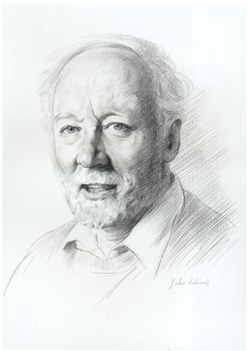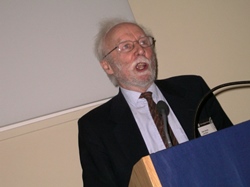 Pioneer of plate tectonic reconstruction, Cambridge University stalwart and stratigrapher.
Pioneer of plate tectonic reconstruction, Cambridge University stalwart and stratigrapher.
The eminent Cambridge geologist Alan Smith (FGS 1961) has died at the age of 80. During his Cambridge career Alan made significant contributions to a number of research fields from plate motion and reconstruction to the tectonics of Greece and the development of the geological timescale.
Although he came from an East Anglian family, Alan Smith was born in Watford on 24 February 1937. His father, an accomplished engineer and inventor, made instruments for the Royal Navy during WWII. No doubt Alan got his appreciation of precision and detailed observation from him. A star pupil at Watford Grammar School, Alan matriculated at St John’s College, Cambridge to read Natural Sciences. His interest in geophysics was greatly influenced by the work and ideas of Harold Jeffreys.
Princeton
Even so, upon graduation Alan pursued postgraduate studies at Princeton on the stratigraphy of the western US and Canada. While there, he was exposed to the ‘hot’ new ideas on continental drift being proposed by the likes of Harry Hess. But coming from the Cambridge ‘fixist’ school led by Jeffreys, Alan was initially sceptical of the new theories.
The America of Princeton, its researchers and their ‘can-do’ approach to science and life in general greatly influenced Alan. He was also enamoured by Judy Walton, who worked for Princeton University Press, and they were married before returning to the UK.
Mathematical fit
Back in Cambridge Alan was elected a Fellow of the Geological Society in 1961 and worked with Jim Everett on a mathematical fit of the continents on either side of the Atlantic, which they proved in 1965. During the course of this work Alan was recruited onto the staff of the Department of Geology.
 Continued ‘fitting’ of the more problematic southern continents led to Alan’s 1970 reconstruction of the Gondwanan supercontinent with the late Tony Hallam. This raised the problem of the palaeotectonics of the ‘Tethyan Belt’, which led to his 1971 GSA paper “Alpine deformation and the oceanic areas of the Tethys, Mediterranean and Atlantic” partly informed by Alan’s pioneering fieldwork on tectonics in Greece.
Continued ‘fitting’ of the more problematic southern continents led to Alan’s 1970 reconstruction of the Gondwanan supercontinent with the late Tony Hallam. This raised the problem of the palaeotectonics of the ‘Tethyan Belt’, which led to his 1971 GSA paper “Alpine deformation and the oceanic areas of the Tethys, Mediterranean and Atlantic” partly informed by Alan’s pioneering fieldwork on tectonics in Greece.
Picture: Alan Smith receiving his Lyell Medal, 2008. Photo: Ted Nield
All these data contributed to a refinement of global plate motion. There was a succession of papers and, with the assistance of Lawrence Rush, the development of a computer programme of plate motion used both for teaching and commercial purposes.
Stratigraphy
Problems associated with the development of a geological timescale also intrigued Alan Smith. From the 1980s he worked on the first three editions of ‘A geologic time scale’ (1982, 1990, 2004), which became internationally accepted under the auspices of the International Commission on Stratigraphy. Refinement of the timescale continues today (www.stratigraphy.org).
Following retirement in 2004, Alan continued his research but also developed his watercolour painting and gardening. Alan’s extensive network of friends and colleagues, included many ex-students who had benefited from his quiet, unassuming critical interest and humour. Judy, his wife predeceased him in 2010 and he is survived by his daughter Jessica and granddaughter Mia of whom he was very proud.
Alan was awarded the Society's Bigsby Medal in 1981 and was Lyell Medallist in 2008.
By Douglas Palmer